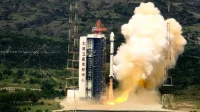India has announced plans for up to 30 launches over a 15-month period, signaling a significant push in both civil and commercial space endeavors.
The planned launches comprise a diverse array of missions, including scientific, commercial, user-funded, and technology demonstration initiatives. Scheduled across the fourth quarter of fiscal year 2023-24 and fiscal year 2024-25, these launches encompass seven test missions dedicated to India's Gaganyaan human spaceflight program and nine under the Indian Space Research Organisation (ISRO).
Additionally, New Space India Limited (NSIL) is orchestrating 14 launches dedicated to India's burgeoning commercial space sector. These launches will involve four Polar Satellite Launch Vehicles (PSLVs), one Launch Vehicle Mark-3 (LVM-3), typically utilized for accessing geostationary orbit, and two Small Satellite Launch Vehicle (SSLV) missions. Seven test launches are allocated for private entities.
Private sector plans include suborbital and orbital launches conducted by firms such as Agnikul Cosmos, with its Agnibaan SOrTeD (Suborbital Tech Demonstrator), and Skyroot Aerospace's Vikram-1.
The Indian National Space Promotion and Authorization Centre (IN-SPACe), established as an independent agency under the Department of Space, recently released the launch manifest on Feb. 8.
The manifest encompasses completed missions, including the early January launch of an X-ray astronomy satellite, and the upcoming INSAT-3DS meteorological satellite mission scheduled for Feb. 17 via GSLV-F14 at 7:00 a.m. Eastern Time.
These initiatives follow the introduction of a new national space policy in 2023, with reforms aimed at positioning India as a global space hub. The ambitious plans reflect an expanding space ecosystem with increasing private sector involvement.
However, challenges loom over India's launch aspirations. Constraints include limited operational spaceports, competing missions across human flight, NSIL, the military, and private entities, as well as supply chain issues related to industrial capacity for building launchers and satellites at scale.
Srinivasan Chandrasekhar, visiting professor at the National Institute of Advanced Studies (NIAS), highlighted uncertainties surrounding the realization of the proposed launch schedule. He suggested a more realistic estimate of 10 to 12 launches over the stated period, emphasizing the significance of such achievements if realized.
Questions also arise regarding commercial plans, particularly concerning the engagement of private players still in development phases. Chandrasekhar noted uncertainties in meeting schedules, with confirmed payloads identified for only two of the NSIL launches.
Nevertheless, opportunities exist for international recognition, such as the European Space Agency's Proba 3 mission, slated for the third quarter of fiscal year 2024-25. The mission could enhance India's standing through the use of PSLV.
Amidst the pursuit of 30 launches, India acknowledges the necessity of long-term efforts to enhance space access and launch frequency. Efforts are underway to address infrastructure limitations, including the construction of a new spaceport at Kulasekarapattinam in Tamil Nadu to cater to private launch service providers.
Looking ahead, Chandrasekhar underscored the importance of fostering domestic industry capabilities to achieve self-reliance in satellite and rocket manufacturing. He emphasized the need for multiple domestic suppliers and a substantial scale-up in launch activities to foster a robust space ecosystem.
India's recent space accomplishments, including the successful Chandrayaan-3 moon landing and the launch of the Aditya-L1 solar observatory in 2023, have set the stage for ambitious future endeavors. Prime Minister Narendra Modi's announcement of plans for an Indian Space Station by 2035 and the aim to send the first Indian to the moon by 2040 reflect sustained efforts and reforms in the Indian space sector, amidst broader challenges yet to be addressed.
Chandrasekhar highlighted the potential benefits of actively promoting Indian industry within the space sector, emphasizing the importance of public-private partnerships to accelerate the development of a robust space ecosystem in the country.







